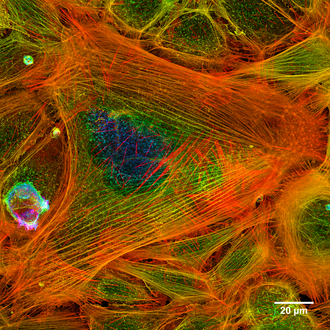Actin





Actin is a family of globular multi-functional proteins that form microfilaments. It is found in essentially all eukaryotic cells (the only known exception being nematode sperm), where it may be present at concentrations of over 100 μM. Actin participates in many important cellular processes, including muscle contraction, cell motility, cell division and cytokinesis, vesicle and organelle movement, cell signaling, and the establishment and maintenance of cell junctions and cell shape.
Structure[edit]
Actin is a highly conserved protein that is approximately 42 kDa in size and is composed of a single polypeptide chain. It has a globular structure (G-actin) that polymerizes to form filaments (F-actin), which are two-stranded helical polymers. The actin filament is dynamic, undergoing continuous polymerization and depolymerization.
Function[edit]
Actin's primary function is to generate mechanical force; this is achieved through ATP hydrolysis. In muscle cells, actin filaments slide past myosin filaments in a process known as the sliding filament theory of muscle contraction. In non-muscle cells, actin polymerization can drive cell movement, such as in amoeboid locomotion, and contribute to changes in cell shape.
Actin is also involved in various cellular processes that are critical for cell survival and function. These include providing structural support to the cell, enabling cytoplasmic streaming, segregating chromosomes during cell division, and facilitating signal transduction pathways.
Isoforms[edit]
In humans, the actin family comprises six isoforms, which are divided into three classes based on their isoelectric points: alpha (α), beta (β), and gamma (γ). Alpha actins are found in muscle tissues and are a major constituent of the contractile apparatus. Beta and gamma actins coexist in most cell types as components of the cytoskeleton and are involved in cell motility.
Regulation[edit]
The polymerization of actin is regulated by a plethora of actin-binding proteins, which can control the length of filaments, cap the ends of filaments, sever filaments, and nucleate the assembly of new filaments. Important regulatory proteins include profilin, which promotes actin assembly; cofilin, which disassembles filaments; and Arp2/3 complex, which nucleates the formation of branched actin networks.
Clinical Significance[edit]
Mutations in actin or actin-regulating proteins are associated with a variety of diseases, including muscle diseases, cardiomyopathies, and certain forms of deafness. Actin is also exploited by many microorganisms and viruses to invade and move within host cells.
Research[edit]
Actin is a subject of extensive research in cell biology and biophysics due to its fundamental role in cellular processes and its involvement in various diseases. Studies of actin have also contributed to the development of drugs that can influence actin dynamics, offering potential therapeutic strategies for diseases associated with actin dysfunction.

Ad. Transform your life with W8MD's Budget GLP-1 injections from $75


W8MD offers a medical weight loss program to lose weight in Philadelphia. Our physician-supervised medical weight loss provides:
- Weight loss injections in NYC (generic and brand names):
- Zepbound / Mounjaro, Wegovy / Ozempic, Saxenda
- Most insurances accepted or discounted self-pay rates. We will obtain insurance prior authorizations if needed.
- Generic GLP1 weight loss injections from $75 for the starting dose.
- Also offer prescription weight loss medications including Phentermine, Qsymia, Diethylpropion, Contrave etc.
NYC weight loss doctor appointmentsNYC weight loss doctor appointments
Start your NYC weight loss journey today at our NYC medical weight loss and Philadelphia medical weight loss clinics.
- Call 718-946-5500 to lose weight in NYC or for medical weight loss in Philadelphia 215-676-2334.
- Tags:NYC medical weight loss, Philadelphia lose weight Zepbound NYC, Budget GLP1 weight loss injections, Wegovy Philadelphia, Wegovy NYC, Philadelphia medical weight loss, Brookly weight loss and Wegovy NYC
|
WikiMD's Wellness Encyclopedia |
| Let Food Be Thy Medicine Medicine Thy Food - Hippocrates |
Medical Disclaimer: WikiMD is not a substitute for professional medical advice. The information on WikiMD is provided as an information resource only, may be incorrect, outdated or misleading, and is not to be used or relied on for any diagnostic or treatment purposes. Please consult your health care provider before making any healthcare decisions or for guidance about a specific medical condition. WikiMD expressly disclaims responsibility, and shall have no liability, for any damages, loss, injury, or liability whatsoever suffered as a result of your reliance on the information contained in this site. By visiting this site you agree to the foregoing terms and conditions, which may from time to time be changed or supplemented by WikiMD. If you do not agree to the foregoing terms and conditions, you should not enter or use this site. See full disclaimer.
Credits:Most images are courtesy of Wikimedia commons, and templates, categories Wikipedia, licensed under CC BY SA or similar.
Translate this page: - East Asian
中文,
日本,
한국어,
South Asian
हिन्दी,
தமிழ்,
తెలుగు,
Urdu,
ಕನ್ನಡ,
Southeast Asian
Indonesian,
Vietnamese,
Thai,
မြန်မာဘာသာ,
বাংলা
European
español,
Deutsch,
français,
Greek,
português do Brasil,
polski,
română,
русский,
Nederlands,
norsk,
svenska,
suomi,
Italian
Middle Eastern & African
عربى,
Turkish,
Persian,
Hebrew,
Afrikaans,
isiZulu,
Kiswahili,
Other
Bulgarian,
Hungarian,
Czech,
Swedish,
മലയാളം,
मराठी,
ਪੰਜਾਬੀ,
ગુજરાતી,
Portuguese,
Ukrainian